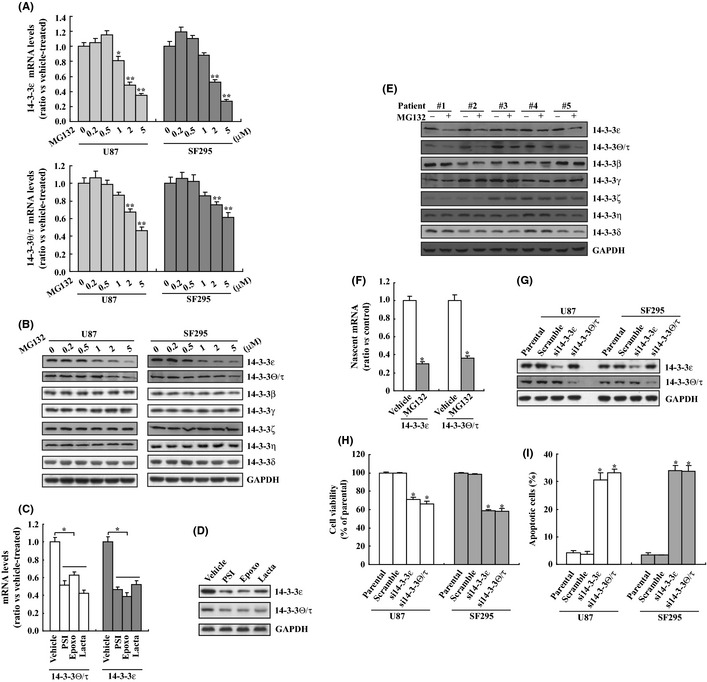Figure 2.

Reduction of 14‐3‐3ε and 14‐3‐3θ/τ by proteasome inhibition in glioma cells. (A) U87 and SF295 cells were treated with the indicated concentration of MG132 for 8 h, and real‐time polymerase chain reaction (PCR) was performed to analyze 14‐3‐3 mRNAs expression. (B) U87 and SF295 cells were treated with the indicated concentration of MG132 for 24 h, and Western blot analysis was performed to investigate 14‐3‐3 proteins expression. (C) U87 cells were treated with the indicated proteasome inhibitor, and 14‐3‐3 mRNA levels were analyzed using real‐time PCR. (D) U87 cells were treated with the indicated proteasome inhibitor, and 14‐3‐3 protein levels were measured using Western blot analysis. (E) Primary human glioma cells were treated with MG132 and Western blot analysis was performed. (F) U87 cells were treated with vehicle or MG132 for 8 h, then nascent RNA was labeled with EU using Click‐iT nascent RNA Capture kit (Life Technology) for an additional 4 h. EU‐nascent RNA was isolated and real‐time PCR was performed. (G) U87 or SF295 cells were transfected with scramble small interfering RNA (siRNA) against 14‐3‐3ε (si14‐3‐3ε) or 14‐3‐3θ/τ (si14‐3‐3θ/τ) for 24 h and Western blot was performed. (H) U87 or SF295 cells were transfected with scramble siRNA, siRNA against 14‐3‐3ε (si14‐3‐3ε) or 14‐3‐3θ/τ (si14‐3‐3θ/τ) for 24 h and cell viability was measured using 3‐(4,5‐dimethylthiazol‐2‐yl)‐2,5‐diphenyltetrazolium bromide (MTT) assay. (I) U87 or SF295 cells were transfected with scramble siRNA, siRNA against 14‐3‐3ε (si14‐3‐3ε) or 14‐3‐3θ/τ (si14‐3‐3θ/τ) for 24 h and apoptotic cells were analyzed using flow cytometry.
